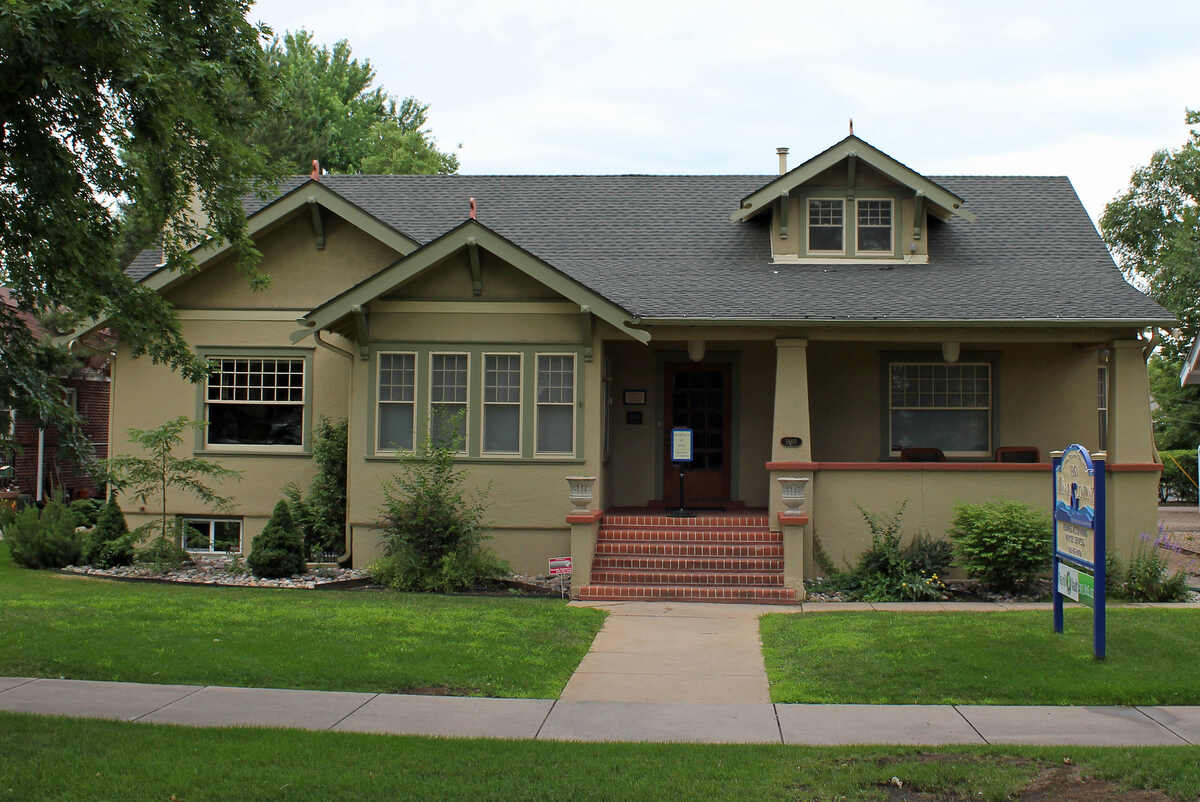
The best grass seed for Colorado includes cool-season varieties like Kentucky bluegrass, perennial ryegrass, and fescue, as well as warm-season varieties like buffalograss and blue grama.
As a Colorado resident, you know keeping a beautiful, healthy lawn can be a little … rocky. With Denver being the original home of xeriscaping to conserve water, there’s pressure on Colorado homeowners to find the right balance between lawn health and climate-friendly maintenance. So this article will help you understand the differences between the grasses and decide which one works best for your needs.
Best Cool-Season Grasses for Colorado
Cool-season grasses, such as Kentucky bluegrass, are your best bet when it comes to adapting to Colorado’s yearly temperature fluctuations. With the hottest summer days blazing into the 90s and the coldest winter nights dipping below zero, you need a grass type that won’t die in extreme heat or cold.
Cool-season grasses can remain green throughout the year and grow most actively during the cooler months of fall and spring. They’re easy to take care of and resistant to wear and tear.
Best of all, there’s no need to worry about much maintenance during the summer months, as cool-season grasses will go dormant in the heat to conserve energy and water. However, it’s important to keep up with occasional irrigation during the hottest, driest weeks.
Here are the best cool-season grasses for Colorado homeowners to choose from:
Kentucky Bluegrass

Photo Credit: Joshua Boman / Shutterstock
Kentucky bluegrass is the star of the show in the Centennial State. With its deep blue-green color, it’s an easy-to-establish turf that spreads quickly through underground rhizomes. Despite being quite tough and able to handle heavy foot traffic, it does need some love here and there.
Kentucky bluegrass can get a bit thirsty in the warmer months, so regular watering (especially in the morning) and fertilization three times a year can keep it looking its best (see “When to Fertilize Your Colorado Lawn”).
Bonus tips:
- Give Kentucky bluegrass a good drench once a week to keep it looking its very best in Colorado. In spring and fall, a weekly inch of water is all this grass needs. When summer’s in full swing, ramp up to 1.5 inches, and you’ll be set. Remember: Deep water encourages deep root systems — and the healthier those roots, the happier your lawn.
- Double down on your care and aerate the soil twice a year. This will not only make sure all the essential oxygen, water, and nutrition get down into the soil, but it will also make sure your grass stays lush and vibrant.
- Get your lawn mower out and mow regularly (and correctly). Vary the height, too. During spring and summer, aim for 2.5 to 3 inches. This is particularly important if you’re expecting a lot of foot traffic.
Main Characteristics:
- Classification: Cool-season grass
- Spreads by: Rhizomes
- Shade tolerance: Low
- Drought tolerance: Moderate
- Foot traffic tolerance: Moderate
- Maintenance needs: Moderate
- Mowing height: Set mowing height between 2.5 and 3 inches
- Potential for disease: Moderate to high
- Soil pH: 6-7.5
- Soil type: Performs best in well-drained, heavy soils with high fertility.
Grass Seed Options:
– Jonathan Green (11970) Blue Panther Kentucky Bluegrass Grass Seed (3 lbs.)
– SeedRanch Midnight Kentucky Bluegrass Seed (5 lbs.)
Perennial Ryegrass
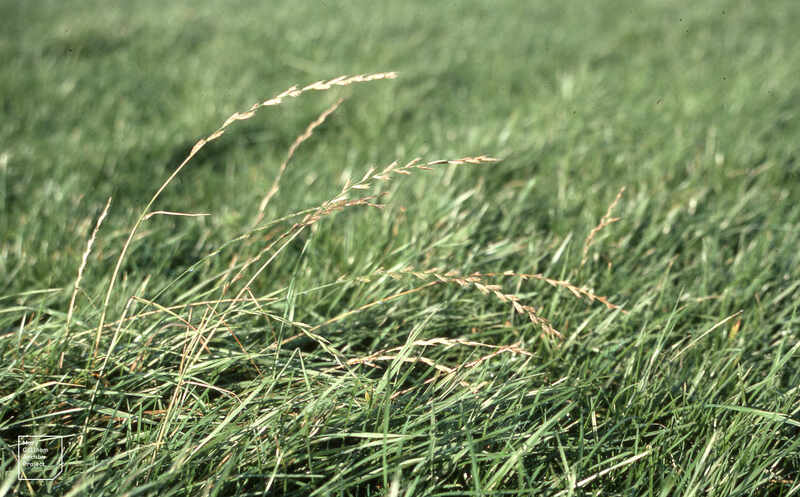
Photo Credit: Dr Mary Gillham Archive Project / Flickr / CC BY 2.0
When it comes to fast-acting results in your lawn, nothing beats perennial ryegrass. It germinates fast and forms a solid lawn foundation quickly. Even though it may be a bit lighter in color than Kentucky bluegrass, mixing the two can create the perfect combination in terms of rapid germination.
Perennial ryegrass thrives in soils of any type, is traffic-tolerant, and is perfect for lawns, sports fields, parks, and golf courses alike. To get the most out of it, you have to water it deeply when needed and fertilize it four times a year, ideally in:
- Early spring (early March)
- Early summer (June)
- Mid-to-late summer (late August)
- Fall (October to early November).
Perennial ryegrass is also great for erosion control and reducing weed competition.
Main Characteristics:
Classification: Cool-season grass
Spreads by: Has a bunch-type growth habit
Shade tolerance: Low
Drought tolerance: Low
Foot traffic tolerance: High
Maintenance needs: Moderate. Thatch is not significant.
Mowing height: Set mowing height to 1.5 to 2.5 inches
Potential for disease: High.
Soil pH: It can grow in acidic to alkaline soils, with a pH range of 5 to 8, but it prefers more neutral soils, between 6 and 7.
Soil type: Perennial ryegrass does great in fertile, well-drained soil, but it can adapt to many other soil types.
Grass Seed Options:
– Outsidepride Perennial Ryegrass Seed (5 lbs.)
– Eretz ProTurf Perennial Ryegrass Fine Lawn Seed (choose your size)
Tall Fescue

Photo Credit: Aaron J. Patton, Ph.D. / Turfgrass Extension Specialist at Purdue University
Tall fescue is an ideal choice for Colorado homeowners looking for a durable turf that will provide a lush, green lawn — even in the worst of drought and shade. Tall fescue’s quick germination and deep root system have made it the go-to choice for both residential and commercial properties that get foot traffic.
Plus, tall fescue requires little fertilizer and is resistant to most pests and diseases, making it easier to maintain than other grasses. Just keep in mind that it’s important to provide good soil drainage for this grass to thrive and to avoid using too much nitrogen-based fertilizer. And be sure to water your lawn correctly and mow it once or twice a week during its active growth season.
One little caveat — it doesn’t spread quickly, so you may want to mix it with other grasses for more uniform growth.
Main Characteristics:
Classification: Cool-season grass
Spreads by: Produces short rhizomes but has a bunch-type growth habit
Shade tolerance: Moderate
Drought tolerance: Moderate to High
Foot traffic tolerance: Moderate
Maintenance needs: Frequent mowing. Does not produce significant thatch.
Mowing height: Set mowing height to 2 inches when grass reaches 3 inches tall.
Potential for disease: If you take good care of it, your grass can handle most diseases.
Soil pH: 5.5-6.5
Soil type: Tall fescue thrives in a variety of soil types, but it loves good fertile clay soil that drains well.
Grass Seed Options:
– Triple-Play Tall Fescue Grass Seed Blend (5000 sq ft)
– Eretz Kentucky 31 K31 Tall Fescue Grass Seed (choose your size)
– Pennington The Rebels Tall Fescue Grass Seed Mix (7 lb.)
Fine Fescue
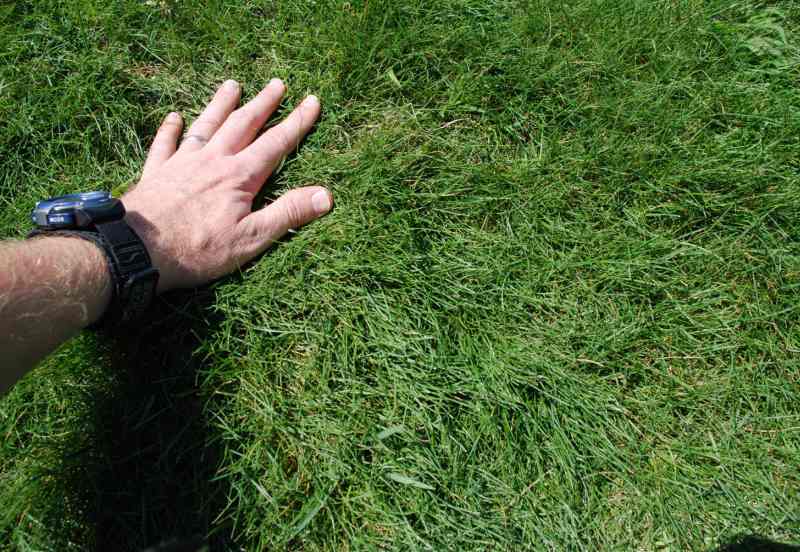
Photo Credit; Aaron J. Patton, Ph.D. / Turfgrass Extension Specialist at Purdue University
Fine fescue is “fine” — it’s not an exaggeration —and it is also one of the most versatile and toughest types of grass you can find in Colorado. It’s perfect for clay, sandy, and rocky soils and can thrive in low light levels. Plus, you needn’t worry about water use with fine fescue, as it’s pretty drought-resistant and moderately salt-tolerant.
But don’t forget to give fine fescue a good fertilizer once or twice a year, especially in late summer or early fall (September). Avoid fertilizer applications over the summer, and keep an eye out for pests like billbugs, grubs, and winter mites. The lawn disease red thread could point to a need for fertilizer, but it’s generally harmless.
There are five types of fine fescue:
- Hard fescue
- Chewings fescue
- (Blue) Sheep fescue
- Creeping red fescue
- Slender creeping red fescue
All five types of fine fescue make excellent choices for Colorado lawns, as they require only 18-20 inches of water per year while handling the state’s cold temperatures with ease. The problem is, they don’t do so well under pressure — literally. Since they take some time to recover from injury, it’s best to avoid traffic in your fine fescue areas.
Main Characteristics:
Classification: Cool-season grass
Spreads by: Creeping red fescue spreads by rhizomes, while other fine fescues are bunch-type grasses, such as Chewings, hard, and sheep fescues.
Shade tolerance: Moderate to High, depending on species
Drought tolerance: Moderate to High, depending on species
Foot traffic tolerance: Low to Moderate, depending on species
Maintenance needs: Low fertilizer and mowing needs
Mowing height: Set mowing height between 2.5 and 4 inches, depending on species.
Potential for disease: Moderate.
Soil pH: 6-6.5
Soil type: Fine fescue prefers drier soil and can handle a range of soil types and nutrition levels.
Grass Seed Options:
– Outsidepride Legacy Fine Fescue Grass Seed (5 lbs.)
– Eretz Creeping Red Fine Fescue Seed (choose your size)
– Outsidepride Creeping Red Fine Fescue Grass Seed (25 lbs.)
– Outsidepride Hard Fine Fescue Grass Seed (10 lbs.)
Best Warm-Season Grasses for Colorado
Colorado’s quite the character — with mountain peaks, unpredictable weather, and four distinct seasons. But while cool-season grasses are the OG when it comes to Rocky Mountain lawns, don’t overlook loving the sunnier types. Sure, Colorado can be quite cold in the winter in the higher elevations, but lower down — think Eastern Plains and the Denver metro area — there’s a lot of sunshine to go around.
As such, the Centennial State is not without its warm-season grass options. Native grasses like buffalograss and blue grama are no strangers to Colorado’s hot summers and dry spells. They’re built for surviving! Better than any cool-season grass, these warm-season buddies have been generally conquering the Southern parts of the state for years.
Both require minimal water and are extremely low maintenance, making them great for a xeriscaping project or anyone who doesn’t want to be stuck with a lot of yard work. However, due to their limited cold tolerance, these grasses will usually require some TLC and due diligence, especially in winter.
Buffalograss
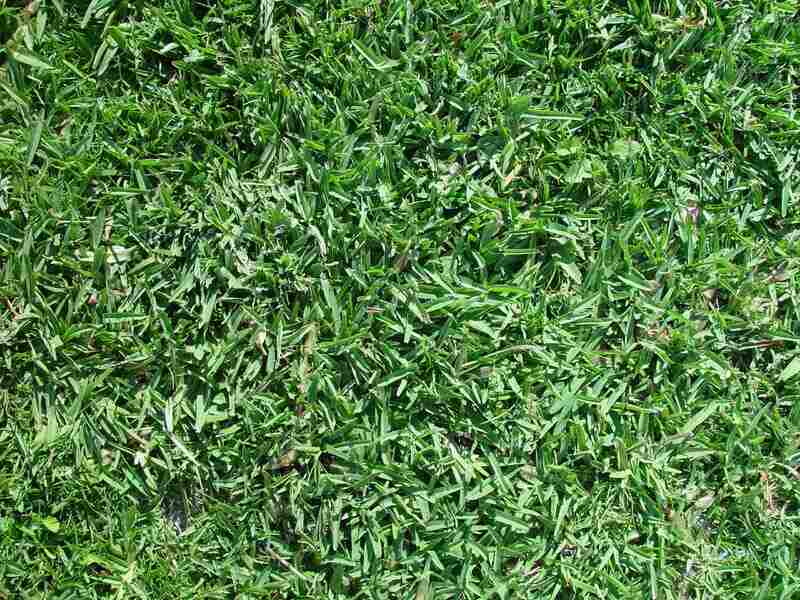
Photo Credit: Pixnio
Native to the Great Plains, buffalograss thrives in dry and slightly alkaline conditions. It’s the perfect companion for homeowners looking for a low-maintenance and less thirsty option — not to mention its charming blue-green hue.
From late May through early September, buffalograss actively grows, so the summer months are when it really shines. Plus, newer turf-type varieties are quite short-growing and are designed to resist weed infestations.
This grass isn’t for everyone, though.
If you’re hoping to grow buffalograss — whether seeded or sodded — keep an eye out for your soil type. It won’t survive in saline soils or higher elevations above 6,500 feet. And, unfortunately, it’s not so good in the shade, either.
Bonus tips:
- Fertilize sparingly. Buffalograss isn’t a fan of excessive nutrients, so don’t overdo it. Stick to 2 pounds maximum per 1,000 square feet over the course of the growing season. Best time to fertilize: late May and mid-July.
- In summer, buffalograss needs 1-2 inches of irrigation per two to four weeks. Start early, if necessary – unless you want the weeds making your property their home (around late May should do it).
- Weeds? Use pre-emergent herbicides for safer, better control.
- Love the shade, but don’t want to miss out on using buffalograss? Mix it with other grasses tolerant to shadier spots.
- Sod over seed: It is much easier to grow buffalograss from sod than seed.
Main Characteristics:
Classification: Warm-season grass
Spreads by: Stolons
Shade tolerance: Low
Drought tolerance: High
Foot traffic tolerance: Low
Maintenance needs: Low fertilizer and mowing needs. Requires weed control
Mowing height: Set the mowing height between 2 and 3 inches
Potential for disease: Good tolerance against diseases and insects
Soil pH: 6.5-7.5
Soil type: Native clay soils, not sandy soils.
Grass Seed Options:
– Everwilde Farms Buffalograss Seeds (1 lb. of seeds)
– Scotts Pursue Buffalograss with Natural Seed (1 lb. of seeds)
Blue Grama Grass
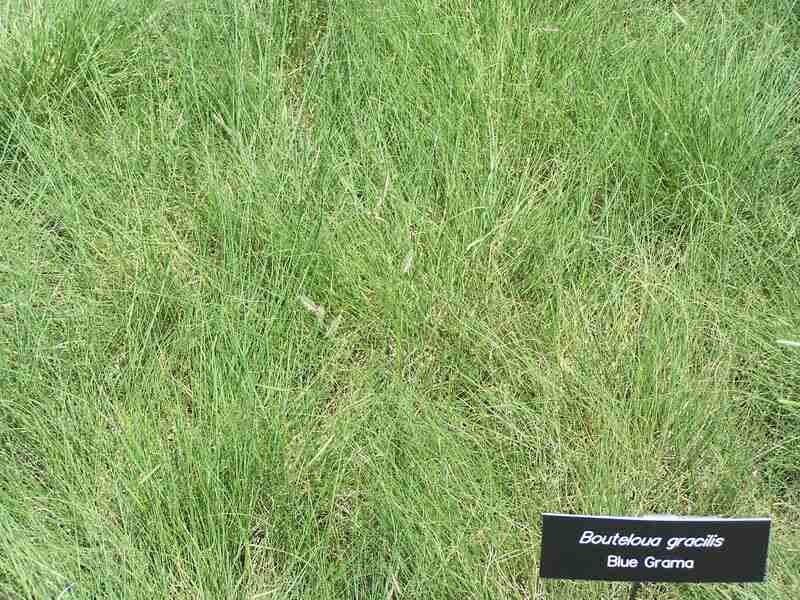
Photo credit: SEWilco / Flickr / CC BY-SA 3.0
Blue grama won’t make a fashion statement like Kentucky bluegrass, but it packs a punch where needed. In fact, blue grama grass is the official state grass of Colorado.
Blue grama is a low-growing warm-season grass that offers low water usage and ecological balance. With fresh, green blades during the summer season (May to October), attractive seed heads in August, and a light tan color during the winter, it’s not hard to see why blue grama has become one of the top choices for Colorado’s lawns.
It doesn’t handle heavy foot traffic that well, so if your yard is a hot spot for outdoor activities and games — you might want to think of alternatives.
Much like the rest of Colorado’s native grasses, blue grama requires little fertilization and watering once a week (or more, during dry spells). One simple tip for all native warm-season grasses in Colorado: Do yourself a favor and mow no more than three times in a season. As for seedlings, plant them in June to avoid all the pesky weeds.
Main Characteristics:
Classification: Warm-season
Spreads by: Rhizomes
Shade Tolerance: Low
Drought Tolerance: High
Foot Traffic Tolerance: Low
Maintenance Needs: Low
Mowing Height: Set mowing height between 2 and 3 inches
Potential for Disease: Low to Moderate. Its most prevalent disease is fungal rust.
Soil pH: 6.6-8.4
Soil Type: Tolerates a wide range of soil textures, including clays and sandy or gravelly loams. Does not perform well in wet, poorly drained soils.
– Everwilde Farms Blue Grama Grass Seeds (1 lb.)
– Nature’s Seed Blue Grama Grass Seeds (1 lb.)
Colorado Climate, USDA Hardiness Zones, and Soil Type
Colorado is definitely a jack of all trades when it comes to climate and soil type. Situated in the Rocky Mountains, the state’s climate can range from humid and sub-tropical in the lower elevations to semi-arid and cold alpine in higher zones, depending on the geographical region.
The Centennial State has a cool, dry climate overall, with extreme temperature ranges and large fluctuating day-to-night changes. The amount of precipitation and average temperatures depend heavily on the altitude, orientation of the mountain ranges, and geographical area. Summer months are typically hot and dry, while winter storms bring blizzards, heavy winds, and snowfall.
Tornadoes are more common in north-eastern Colorado, but winds like chinooks or boras are known to be destructive and can occur in any part of the state.
USDA Hardiness Zones in Colorado
If you want to play it safe and keep your lawn looking great, you must consider where you live within the state. The Plant Hardiness Zone Map of Colorado takes into account minimal winter temperatures to determine which plants are suitable in each part. From zones 3a to 7a, Colorado can be divided into seven different hardiness zones, each with its own characteristic climate.
Eastern Colorado falls into the 5a or 5b zone and is located in the plains and foothills where dry air, temperatures of 0-15 degrees Fahrenheit, and winds dominate the landscape. While higher mountain elevations drop down to Zones 3 and 4, the west and southeast parts of Colorado make it into the 6a and 7a zones, enjoying a warmer climate with longer growing seasons.
Soil Challenges in Colorado
Colorado’s soil has some unique challenges for lawns and gardens. With its lack of rain, the topsoil tends to be thin and clay-like, making it tough for grass to take root. Rocky soils and high pH levels don’t help, either. Adding organic matter like compost or mulch can really enrich the soil, so give it a shot. Aeration also helps promote deeper roots.
As for fertilizer, a starter version is best for seedlings, but watch out for ones with too much nitrogen content, as that can damage your grass down the line. And don’t forget to measure the soil pH every now and then. That way, you’ll always know what’s going on beneath your lawn.
How to Choose the Right Grass Seed for Your Colorado Lawn
Choosing the right grass seed for your Colorado lawn comes down to a few main considerations, including:
- Climate – Check the USDA Plant Hardiness Zone Map and determine the type of climate you have in your area.
- Location – Your soil type and exposure to sunlight will play a big role in forming your lawn:
- If your soil is clay-based, consider turf-type varieties of Kentucky bluegrass and tall fescue.
- For sandy or rocky soils, fine fescue will do a better job.
- Consider optimizing the ratio of Kentucky bluegrass and perennial ryegrass for a shade-resistant lawn.
- Water usage – Some turf types are more drought-tolerant than others. If your local water restrictions are too tight for certain grasses, you may want to consider buffalograss or blue grama.
- Usage – Different grass species can be used for various purposes, such as sports field turf or simply general lawns and gardens. For instance, Kentucky bluegrass is great for foot traffic, while buffalograss should be used in less-trafficked areas.
Essential Lawn Care Tips for Colorado Residents
Colorado’s dry, hot climate can make it challenging to keep a lawn looking healthy, but remembering a few basics can help you get the most out of your grass.
- Water in the early morning so that your lawn gets a good drink before the day’s heat sets in. Avoiding frequent, shallow watering is always a good practice here, and deep, infrequent watering can help keep weeds at bay.
- Test your soil to make sure you’re using the right fertilizers and nutrients to give your lawn the best care possible.
- Mow your grass to the right height. The ideal mowing height for all lawn species is 2.5 to 3 inches. During peak growth periods, you may need to mow every 3-4 days (depending on your grass type) to maintain this height.
- Fertilize with quick-release nitrogen during the spring for fast green-up and slow-release nitrogen throughout the summer and fall for sustained greening.
- Water efficiently. Water requirements typically range from 0.75 inches to 2.25 inches of water per week, depending on climate conditions and grass species. Of course, you’ll have to take drought water restrictions into account, as well. See our guide on how to water your lawn in Colorado to learn more.
- Thatch and soil compaction: Thatch can build up over time and lead to soil compaction, reducing the oxygen levels in your lawn and hindering growth. Core aeration is a great way to combat soil compaction and improve oxygen levels. Aerate in early spring or early fall.
- Weed and disease control: Deep, infrequent watering can help prevent shallow-rooted weeds, and cultural practices like mowing and fertilizing can help reduce weed seed germination.
- Overseeding: Overseeding is an easy and effective way to cover sparse areas of your lawn and make it thicker. The best time to do so is early April or the first part of September.
And, of course, if you’re looking for something that doesn’t require all this maintenance, xeriscaping is an excellent low-maintenance, water-wise alternative to a traditional lawn. Since Colorado is the birthplace of this eco-friendly landscaping technique, it’s pretty easy to get started here! Learn more in our guide to xeriscaping in Colorado.
FAQ About the Best Grass Seed for Colorado Lawns
It depends on the type of grass. Paying attention to the season and timing can make all the difference between a healthy lawn and a patchy, struggling one. For cool-season grasses like Kentucky bluegrass, ryegrass, and fescues, the optimal time to plant in Colorado is from mid-August to mid-September.
On the other hand, warm-season grasses such as buffalograss and blue grama should be planted from April to early July. Keep in mind that seeding in the middle of summer can be difficult and yield less than desirable results, so aim for earlier if you can.
The best grass seed to resist drought in Colorado is native grass such as buffalograss and blue grama. These require less water, thrive in hot climates, and have deep roots that can better absorb moisture.
Tall fescue is an excellent choice when it comes to Colorado’s high altitudes, as it can grow in cool, arid climates.
For Denver, cool-season grasses still work best. Kentucky bluegrass and ryegrass are the best grass types for Denver, as they provide good coverage and are slow to thin out. Fescue might suffer more in the heat, so mix it with other types of grass to create a more resilient lawn.
Xeriscaping in Colorado is an eco-friendly way to keep your lawn green without using a ton of water. It’s not like people think — you can’t just leave xeriscaping alone without any water! It’s all about using smart water practices and selecting native plants for Colorado‘s dry climate. Though these plants need some water, it’s a fraction of what a typical garden needs.
Planting Grass Seed in Colorado: DIY or Hire a Lawn Care Pro
Any gardening project can be a hassle, especially if you’re working around the weather and soil challenges of Colorado. But that doesn’t mean your grass can’t be lush, diverse, and sustainable. Before you buy any grass seed, do your homework and customize the mix for your unique set of needs, such as soil, climate, and activity level. Don’t be scared to experiment, either.
If you need a little extra help, contact a Colorado lawn expert near you — he or she will give you great advice to get the perfect grass seed for your lawn. No matter where you are, be it Fort Collins, Denver, or Colorado Springs, LawnStarter knows a lawn care wizard near you who knows just the trick to make your yard look perfect!
LawnStarter participates in the Amazon Services LLC Associates Program, an affiliate advertising program. LawnStarter may earn revenue from products promoted in this article.
Main Image Credit: Jeffrey Beall / Flickr / CC BY-SA 2.0